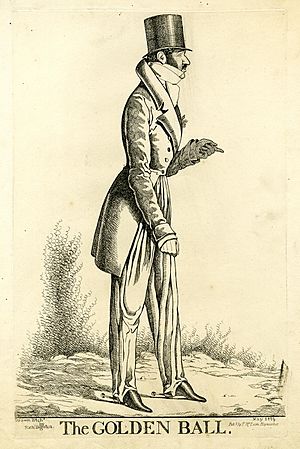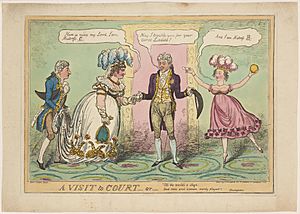Edward Hughes Ball Hughes facts for kids
Edward Hughes Ball Hughes (born May 28, 1798 – died March 10, 1863) was a famous English dandy. A dandy was a man who cared a lot about his looks and fashion. People called him "The Golden Ball" because he lived a very fancy and expensive life.
Contents
Early Life and Style
Edward Hughes Ball Hughes was born in Lambourne, Essex, England. He went to school at Eton and then to Trinity College, Cambridge. He spent some time in the army with the 7th Hussars. But he soon left the army to enjoy his large family fortune.
Edward quickly became known for his great wealth and his very fancy lifestyle. People even made pictures of him as early as 1819. He was known for his special chocolate-colored coach. He also invented the black cravat, which was a type of necktie.
In 1823, Edward married Maria Mercandotti. She was a 16-year-old Spanish dancer. They later separated and divorced in 1839.
Big Purchases and Money Matters
In 1824, Edward Hughes Ball Hughes bought Oatlands Palace from the Duke of York. This was a very large estate. He later sold parts of the land for houses. This helped create the modern town of Oatlands and was a good business deal for him.
Edward spent a lot of money on his fancy lifestyle and on gambling. Because of this, he lost huge amounts of money. In 1829, he had to move to France to avoid people he owed money to. His lawyers managed his money and sent him an allowance to live on. Even then, he still had a lot of money. In 1832, he owned $51,000 in stock in an American bank.
In 1834, Edward also gained control of the town of Sidmouth. He helped pay for a new sea wall for the town in 1835. He also helped build a new market for Sidmouth. A law was passed in 1846 to make sure everyone used this new market.
His Family Background
Many stories were told about Edward's family, but most were not true. His grandmother, Ruth, married Admiral Edward Hughes. The Admiral helped her son, Captain Henry Ball, in his navy career.
Admiral Hughes passed away in 1794 without having any children of his own. So, Edward Hughes Ball Hughes inherited the Admiral's large fortune. He received 40,000 pounds a year when he turned 21. At that time, he added "Hughes" to his last name.
Edward had several sisters. His older sister, Catherine Ball, was a writer and a socialite. She later called herself the "Baroness de Calabrella". Another sister, Ruth, married Houlton Hartwell in 1812. He was a chaplain to the Prince Regent. A third sister, Sydney, married Sir John Ignatius Burke. There was also a fourth sister, Elizabeth Ball. It's important to know that the sculptor Robert Ball Hughes was not related to Edward.
While living in France, Edward had children with Eliza Breugnot Monborne. They had Edward Seymour, Adeline Eleanor, and Sydney Matilda. Edward Seymour died in 1867 after a horse accident. Adeline married Ernest Louis Auguste Graves Van der Smissen. Sydney Matilda married twice.
Edward later had more children with Anne Henriette de Dauvet. They had Edward Edmund Hughes Ball Hughes and Kate Henrietta Edwardine Hughes Ball Hughes. Edward Hughes Ball Hughes died in St. Germains, France, when he was 64 years old.
Famous Pictures of Edward
A drawing of Edward Hughes Ball Hughes was made by Alfred d'Orsay. This drawing is now in the National Portrait Gallery in London. Edward and d'Orsay knew each other. Edward even went to d'Orsay's funeral.
Many funny drawings, called caricatures, were made of Edward and his wife. For example, Richard Dighton published a picture of him in 1819 called The Golden Ball. In 1825, Robert Cruikshank made a caricature about Edward's wife. Edward was also featured on "Dandies" cigarette cards in 1932. These cards were made by Player's.
Edward in Books
Edward Hughes Ball Hughes was a very colorful person during the Regency period in England. Because of this, he is mentioned in many books set in that time.
Some of the books that mention him include:
- Georgette Heyer's Sylvester
- False Colours
- Arabella
- Regency Buck
- Cotillion
- Jeffery Farnol's The Amateur Gentleman
These books help show how well-known Edward Hughes Ball Hughes was in his time.
Images for kids





